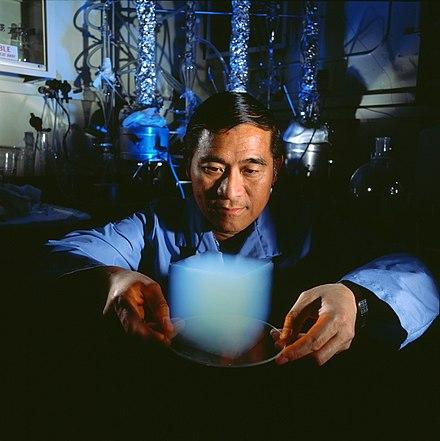In India, water quality issues are diverse, ranging from oil and toxic metal contamination from garages and small industry by a river to salinity in coastal regions due to land management practices and climate change. Simple low cost solutions are required now, to deliver on securing the basic human right of clean water to all members of society. Aerogels may well just provide that opportunity. But what are they?

Well, aerogels are the world’s lightest solid material and are similar in construction to open cell foams. Early aerogels made of silica were termed ‘blue smoke’ due to their optical properties and are >95% empty space, possess mechanical strength, excellent thermal properties and elasticity (Kistler and Caldwell, 1934). Aerogels have evolved since the 30’s and now can be made from a number of precursors including polymers, metal oxides, Graphene and Carbon Nanotubes. This diversity of precursors has led to a wide range of applications, for example, water and air filtration, insulation on space probes and energy storage for Li-ion batteries (Bheekhun et al., 2013, Duxbury, 2001).
Potable and wastewater treatment is of particular interest for aerogel research as the material has an extremely large specific surface area to volume ratio, potentially yielding a maximum number of binding sites per unit weight to adsorb and remove contaminants; the efficacy of this principle has already been demonstrated in a deconstructed Graphene foam for wastewater treatment (Tabish et al., 2018). Graphene oxide and cellulose nanofibril hybrid aerogel demonstrated the adsorptive removal of 21 antibiotics simultaneously (Yao et al., 2017).Graphene-based Aerogels have also taken a front seat recently due to their applications in adsorption of oil and other solvents from water (Kabiri et al., 2014). The heart of this mechanism is the nanoporous nature that facilitates the either the passage or rejection of the oil/solvent through the structure. A predominant characteristic of aerogels is that the internal surface area is very large when compared to its volume, resulting in unique properties similar to other nanomaterials. This large surface area can be functionalised, make it either water ‘loving’, hydrophilic, or oil ‘loving’, oleophilic. Usually, if an aerogel ‘loves’ water is ‘hates’ oil, this makes it hydrophilic and oleophobic, the graphene oxide aerogels developed during this researcher exchange were made like this (for more information please refer to the activity report here).

I know what you’re thinking, ‘why would you want to soak up all of the water, this is good stuff, right?’ By capturing large amounts of contaminated water and allowing it to pass freely through the aerogel reverses the logic of typical foams for adsorption, this also eliminates the need for a compressive stage to squeeze out the oil/solvent for recovery. Figure 2 illustrates how a simple gravity system separates, in this case, crude oil from the water. This graphene oxide aerogel is not only biocompatible and biodegradable but remarkably efficient for oil water separation.
The impacts of crude oil in marine ecosystems is well established and sadly, often experienced, as illustrated by Exxon Valdez oil tanker running aground during the late 1980’s to the more recently exposed pollution in the Niger delta, all of which have left huge amounts of ecological damage in their wake (Opukri and Ibaba, 2008, Peterson et al., 2003). However, and alarmingly, the same is not the case for freshwater ecosystems, where the impacts of oil pollution is relatively unknown (Wilson and Jones, 1993; https://www.iisd.org/blog/exploring-what-oil-spills-do-fresh-water)We know that immediate and effective clean-up operations are paramount in preserving the natural environment, saving lives, money and valuable natural resources. Hence, the development of this low-cost but effective graphene oxide aerogel in an Indian laboratory will spur further investigations into other aerogels that can continue to support improvements in water treatment methodologies and systems.
REFERENCES
Bailey, N., Jobson, A. & Rogers, M. 1973. Bacterial degradation of crude oil: comparison of field and experimental data. Chemical geology, 11, 203-221.
Bheekhun, N., Talib, A., Rahim, A. & Hassan, M. R. 2013. Aerogels in aerospace: an overview. Advances in Materials Science and Engineering, 2013.
Duxbury, T. 2001. The NASA Discovery STARDUST Project.
Kabiri, S., Tran, D. N., Altalhi, T. & Losic, D. 2014. Outstanding adsorption performance of graphene–carbon nanotube aerogels for continuous oil removal. Carbon, 80, 523-533.
Kistler, S. & Caldwell, A. 1934. Thermal conductivity of silica aerogel. Industrial & Engineering Chemistry, 26, 658-662.
Opukri, C. & Ibaba, I. S. 2008. Oil induced environmental degradation and internal population displacement in the Nigeria’s Niger Delta. Journal of sustainable Development in Africa, 10, 173-193.
Peterson, C. H., Rice, S. D., Short, J. W., Esler, D., Bodkin, J. L., Ballachey, B. E. & Irons, D. B. 2003. Long-term ecosystem response to the Exxon Valdez oil spill. Science, 302, 2082-2086.
Tabish, T. A., Memon, F. A., Gomez, D. E., Horsell, D. W. & Zhang, S. 2018. A facile synthesis of porous graphene for efficient water and wastewater treatment. Scientific reports, 8, 1817.
Wilson, S. C. & Jones, K. C. 1993. Bioremediation of soil contaminated with polynuclear aromatic hydrocarbons (PAHs): a review. Environmental pollution, 81, 229-249.
Yao, Q., Fan, B., Xiong, Y., Jin, C., Sun, Q. & Sheng, C. 2017. 3D assembly based on 2D structure of cellulose nanofibril/graphene oxide hybrid aerogel for adsorptive removal of antibiotics in water. Scientific Reports, 7, 45914.